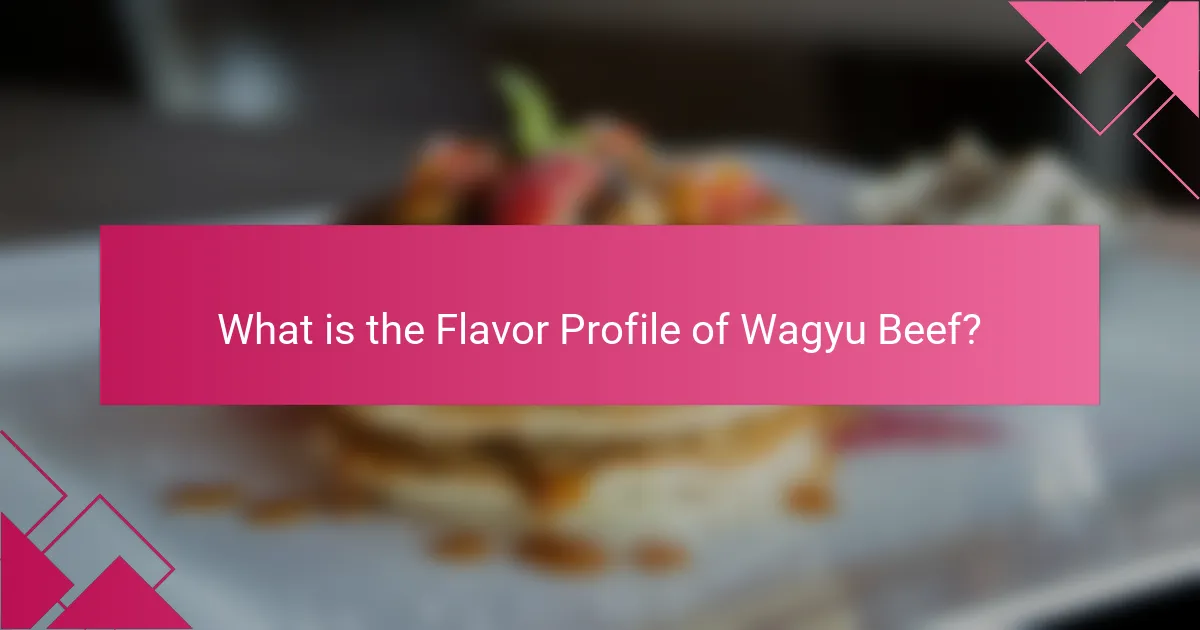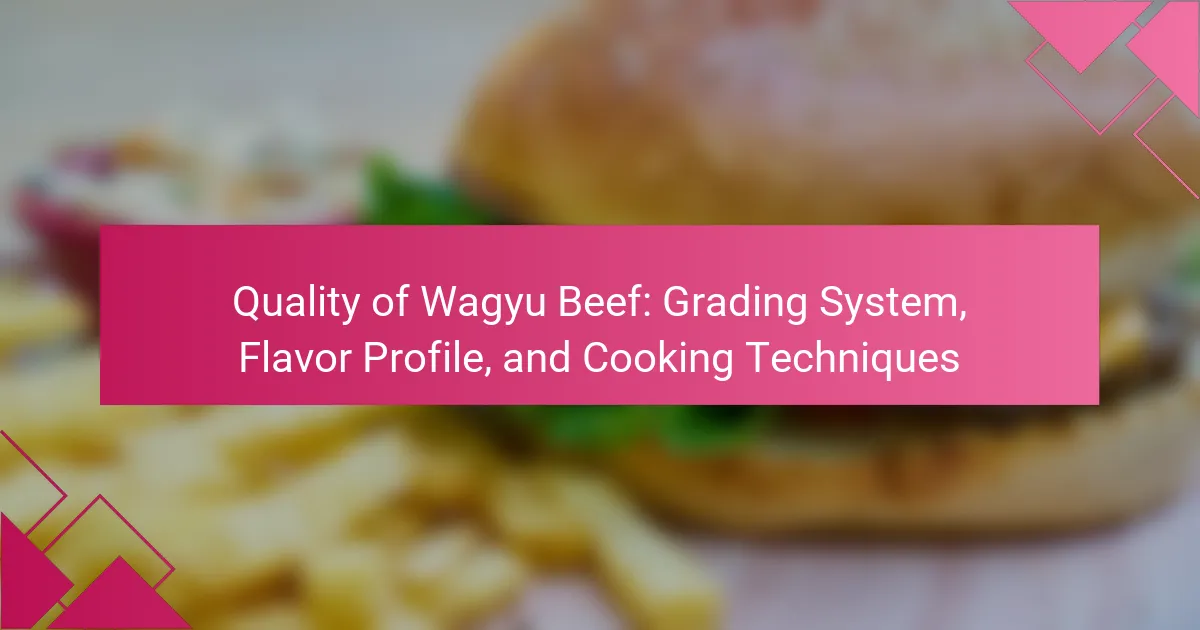
What is the Quality of Wagyu Beef?
Wagyu beef is renowned for its exceptional quality, characterized by intense marbling and tenderness. The marbling in Wagyu beef contributes to its rich flavor and juiciness. This beef is graded based on the Japanese grading system, which evaluates marbling, color, and texture. High-grade Wagyu, such as A5, exhibits the highest levels of marbling and quality. The unique genetics of Wagyu cattle significantly influence the quality of the meat. Research indicates that Wagyu beef has a higher percentage of monounsaturated fats compared to other beef types. This fat composition enhances the flavor profile and health benefits. The overall quality of Wagyu beef is a result of meticulous breeding, feeding practices, and grading standards.
How is Wagyu beef defined and distinguished from other beef types?
Wagyu beef is defined as a premium type of beef originating from specific Japanese cattle breeds. It is distinguished from other beef types primarily by its intense marbling and unique flavor profile. Wagyu cattle are raised under strict conditions, often including special feeding regimens and limited stress. The marbling in Wagyu beef results in higher intramuscular fat, which contributes to its tenderness and rich taste. In Japan, Wagyu is graded based on yield and quality, with the highest grades being A5. This grading system assesses factors such as marbling, color, and texture. The distinct characteristics of Wagyu beef set it apart from typical beef varieties, which generally have less marbling and a firmer texture.
What are the key characteristics that define Wagyu beef?
Wagyu beef is characterized by its high marbling, tenderness, and rich flavor. The marbling, or intramuscular fat, significantly enhances its juiciness and taste. Wagyu cattle are raised under strict conditions, contributing to this unique quality. The breed is known for its genetic predisposition to produce more fat than muscle. Additionally, Wagyu beef often has a buttery texture and a distinct umami flavor profile. The grading system for Wagyu beef evaluates these attributes, with higher grades indicating superior quality. For instance, A5 is the highest grade, reflecting exceptional marbling and tenderness. These characteristics make Wagyu beef highly sought after in culinary applications.
How does the origin of Wagyu beef affect its quality?
The origin of Wagyu beef significantly affects its quality. Wagyu cattle, originally from Japan, are raised in specific regions known for unique feeding and breeding practices. These practices enhance the marbling and tenderness of the meat. For example, Japanese Wagyu is often fed a high-energy diet, which contributes to its rich flavor and texture. Additionally, the strict breeding regulations in Japan ensure that only the best genetics are used, resulting in superior quality. Studies show that Wagyu beef from Japan consistently scores higher on grading scales due to these factors. Therefore, the geographical and cultural context of Wagyu beef production is crucial in determining its overall quality.
What factors influence the quality of Wagyu beef?
The quality of Wagyu beef is influenced by genetics, feeding practices, and rearing conditions. Genetics play a crucial role in determining the marbling and tenderness of the meat. Specific breeds, such as Japanese Black, are known for superior quality. Feeding practices include a high-energy diet that enhances fat deposition. This diet often consists of grains and forages. Rearing conditions also significantly impact quality. Stress-free environments contribute to better meat quality. Additionally, the age at which the cattle are harvested affects tenderness and flavor. Research indicates that younger cattle yield more tender meat. Therefore, these factors collectively determine the overall quality of Wagyu beef.
How does genetics play a role in Wagyu beef quality?
Genetics significantly influences Wagyu beef quality. The breed’s genetic makeup determines traits such as marbling, tenderness, and flavor. Wagyu cattle possess unique alleles that promote intramuscular fat deposition. This fat contributes to the characteristic rich flavor and buttery texture of the beef. Research indicates that specific genetic markers correlate with higher marbling scores. For instance, studies have shown that the presence of certain genes in Wagyu results in superior meat quality compared to other breeds. These genetic factors are essential in breeding programs aimed at enhancing Wagyu beef attributes.
What role does diet and feeding practices have on Wagyu beef quality?
Diet and feeding practices significantly impact Wagyu beef quality. Wagyu cattle are often fed a high-energy diet that includes grains and forages. This diet promotes intramuscular fat deposition, known as marbling. Marbling enhances the tenderness and flavor of the beef. Studies show that a grain-based diet can increase marbling scores. Research indicates that Wagyu fed for longer periods produce higher quality beef. Additionally, feeding practices can vary by region, affecting flavor profiles. The quality of Wagyu beef is often graded based on marbling, color, and texture. Therefore, diet and feeding practices are crucial in determining the overall quality of Wagyu beef.

What is the Grading System for Wagyu Beef?
The grading system for Wagyu beef is based on several criteria, including marbling, color, and texture. The Japanese Meat Grading Association assigns grades using a scale from A to C, with A being the highest quality. Additionally, marbling is rated on a scale from 1 to 12. Higher marbling scores indicate better flavor and tenderness. The combination of these factors results in an overall grade that reflects the beef’s quality. Wagyu beef with higher grades commands premium prices in the market due to its superior characteristics.
How does the Wagyu grading system work?
The Wagyu grading system evaluates the quality of Wagyu beef based on several criteria. It primarily assesses marbling, color, texture, and fat quality. The grading scale ranges from A4 to A5, with A5 being the highest quality. Marbling is the intramuscular fat that contributes to tenderness and flavor. The Beef Marbling Standard (BMS) score ranges from 1 to 12, with higher scores indicating better marbling. Color and brightness of the meat and fat are also crucial factors. The Japanese Meat Grading Association oversees this grading system. This structured approach ensures that consumers receive high-quality Wagyu beef.
What criteria are used to grade Wagyu beef?
Wagyu beef is graded based on several criteria. The primary grading system includes the yield grade and quality grade. Yield grade assesses the amount of usable meat from the carcass. It is rated from A to C, with A indicating the highest yield.
Quality grade evaluates the marbling, color, texture, and fat quality. Marbling is the intramuscular fat that enhances flavor and tenderness. Quality grades range from 1 to 5, with 5 being the highest.
The Japan Meat Grading Association oversees the grading process. This ensures consistency and quality across Wagyu beef products.
How do marbling and fat content affect Wagyu beef grades?
Marbling and fat content are critical factors in determining Wagyu beef grades. Higher marbling scores indicate a greater amount of intramuscular fat. This fat enhances flavor, tenderness, and juiciness. The Japanese grading system uses a scale from A to C, with A representing the highest quality. Grades are further assessed based on the yield grade and quality grade, which includes marbling. For example, A5 is the highest grade, characterized by exceptional marbling and fat content. Research shows that Wagyu beef with higher marbling consistently scores better in taste tests. This correlation between marbling and grade is well-documented in industry standards.
What are the different grades of Wagyu beef?
Wagyu beef is graded based on its quality and marbling. The grading system typically includes A5, A4, A3, B4, B3, and lower grades. A5 is the highest grade, indicating superior marbling and tenderness. A4 and A3 follow, with slightly less marbling. B grades indicate lower quality, with B4 and B3 having less marbling than A grades. The grading is determined by the Japan Meat Grading Association. This system ensures consumers can identify the quality of Wagyu beef.
What distinguishes A5 Wagyu from other grades?
A5 Wagyu is distinguished by its superior marbling, tenderness, and flavor. It represents the highest grade in the Japanese Wagyu grading system. A5 indicates a marbling score of 8 to 12, which is significantly higher than lower grades. The meat’s fat content contributes to its rich, buttery taste. A5 Wagyu also has a unique texture that melts in the mouth. This grade is rare, making it highly sought after. Only a small percentage of Wagyu cattle achieve A5 status. The grading is based on strict criteria set by the Japanese Meat Grading Association.
How does the grading system vary between countries?
It is not possible to answer the question regarding how the grading system varies between countries in the context of the quality of Wagyu beef, as the question does not align with the main topic of the article. The grading system for Wagyu beef is specific to Japan and has unique criteria that may not directly correlate with grading systems in other countries. Thus, a comparative analysis cannot be accurately provided.

What is the Flavor Profile of Wagyu Beef?
Wagyu beef has a rich, buttery flavor profile. This distinctive taste comes from its high marbling of fat. The fat in Wagyu is primarily monounsaturated, contributing to its unique mouthfeel. It has a sweet, umami flavor that enhances its overall richness. The tenderness of Wagyu further intensifies the eating experience. Additionally, the flavor can vary based on the specific breed and feeding practices. Japanese Wagyu, for instance, is renowned for its intense flavor and melt-in-your-mouth texture. Studies have shown that Wagyu beef’s unique composition leads to a more flavorful and tender product compared to other beef types.
How does the flavor of Wagyu beef compare to other beef?
Wagyu beef has a richer, more buttery flavor compared to other types of beef. This distinct taste is primarily due to its high marbling content. Wagyu beef typically contains more intramuscular fat, which enhances its flavor and tenderness. In contrast, most conventional beef cuts have less marbling, resulting in a leaner taste. The unique breeding and feeding practices for Wagyu cattle contribute to this flavor profile. Studies have shown that the fat in Wagyu beef has a higher proportion of monounsaturated fats, which provide a smoother taste. This combination of marbling and fat composition sets Wagyu apart from standard beef varieties.
What are the unique taste characteristics of Wagyu beef?
Wagyu beef is known for its rich, buttery flavor and tender texture. The high level of marbling in Wagyu contributes to its distinctive taste. This marbling creates a melt-in-your-mouth experience when cooked. Additionally, Wagyu has a slightly sweet, umami flavor profile. The breed’s diet and rearing practices enhance these taste characteristics. Studies show that Wagyu beef has a higher fat content compared to other beef types. This fat is primarily monounsaturated, which contributes to its unique flavor. Overall, the taste of Wagyu beef is a result of genetics, diet, and meticulous breeding practices.
How does the marbling of Wagyu beef enhance its flavor?
The marbling of Wagyu beef enhances its flavor by infusing the meat with fat. This intramuscular fat melts during cooking. It creates a rich, buttery texture that elevates the overall taste. The high-fat content also contributes to a unique umami flavor profile. Studies show that marbled beef can have higher levels of monounsaturated fats. These fats are known to enhance flavor perception. The marbling pattern in Wagyu is distinct, which is a key characteristic of its quality. This quality is reflected in the grading system used for Wagyu beef.
What cooking techniques best highlight the flavor of Wagyu beef?
Grilling and pan-searing are the best cooking techniques to highlight the flavor of Wagyu beef. These methods allow the rich marbling of the beef to render properly. The high-fat content in Wagyu enhances its umami flavor when cooked at high temperatures. Sous-vide is also effective, as it ensures precise temperature control, preserving tenderness and flavor.
Cooking Wagyu at medium-rare to medium doneness optimizes its taste and texture. The Maillard reaction during searing enhances the beef’s flavor profile. Using minimal seasoning, like salt and pepper, allows the natural flavor of Wagyu to shine through. These techniques are widely recommended by chefs specializing in high-quality beef.
How does cooking method impact the flavor and texture of Wagyu beef?
Cooking method significantly impacts the flavor and texture of Wagyu beef. Different techniques can enhance or diminish its unique qualities. For instance, grilling allows fat to render, creating a smoky flavor and tender texture. Sous-vide cooking retains moisture and ensures even doneness, highlighting the beef’s rich marbling. Pan-searing can create a crispy crust while maintaining a juicy interior. Overcooking, regardless of method, can lead to dryness and loss of flavor. Research shows that proper cooking techniques preserve the beef’s high-fat content, which is crucial for its signature taste and mouthfeel.
What are the recommended cooking temperatures for Wagyu beef?
The recommended cooking temperatures for Wagyu beef are between 130°F to 145°F (54°C to 63°C). Cooking Wagyu beef at these temperatures ensures optimal tenderness and flavor. For medium-rare, aim for 130°F to 135°F (54°C to 57°C). Medium is achieved at 135°F to 145°F (57°C to 63°C). Cooking Wagyu beyond these temperatures can lead to a loss of its signature marbling and juiciness. This temperature range is backed by culinary experts who emphasize preserving the unique qualities of Wagyu beef.
What are the best practices for cooking and serving Wagyu beef?
The best practices for cooking and serving Wagyu beef include using low heat to preserve its tenderness and flavor. Cooking methods such as sous vide, grilling, or pan-searing are recommended. It is crucial to season lightly, as the beef’s natural flavors are rich. A minimum internal temperature of 130°F is ideal for medium-rare. Resting the beef for at least five minutes after cooking allows juices to redistribute. Slicing against the grain enhances tenderness. Serving with simple sides complements the beef without overpowering it. These practices maintain the quality and experience of Wagyu beef.
How can one ensure optimal tenderness and flavor when cooking Wagyu beef?
To ensure optimal tenderness and flavor when cooking Wagyu beef, it is essential to control cooking temperature and time. Wagyu beef has a high-fat content, which requires gentle cooking to prevent the fat from rendering too quickly. Aim for a cooking temperature of around 130°F to 135°F for medium-rare. This temperature allows the fat to melt slowly, enhancing the flavor and maintaining tenderness.
Using a meat thermometer can help achieve this precise temperature. Additionally, letting the beef rest after cooking for at least 5 to 10 minutes allows the juices to redistribute, further improving tenderness. Searing the beef quickly on high heat can create a flavorful crust without overcooking the interior.
Choosing the right cut also impacts tenderness and flavor. Cuts like ribeye or filet mignon are known for their marbling and tenderness. Proper seasoning, such as a simple sprinkle of salt, can enhance the natural flavor without overpowering it.
What are common mistakes to avoid when preparing Wagyu beef?
Common mistakes to avoid when preparing Wagyu beef include cooking at too high a temperature. High heat can cause the fat to render too quickly, leading to dryness. Another mistake is overcooking the beef. Wagyu is best enjoyed medium-rare to maintain its tenderness and flavor. Not allowing the beef to rest after cooking is also a common error. Resting helps redistribute the juices for better flavor. Using the wrong seasoning can detract from Wagyu’s natural taste. Simple seasoning, like salt and pepper, is often best. Lastly, cutting the beef against the grain is crucial. This technique enhances tenderness and improves the eating experience.
Wagyu beef is a premium type of beef known for its exceptional quality, characterized by high marbling, tenderness, and rich flavor. The article explores the grading system for Wagyu beef, detailing how marbling, color, and texture influence quality ratings, with A5 being the highest grade. It also examines the unique flavor profile of Wagyu, which is enhanced by its high-fat content and specific feeding practices. Additionally, the article outlines recommended cooking techniques and temperatures to maximize tenderness and flavor, while highlighting common mistakes to avoid when preparing this sought-after beef.
